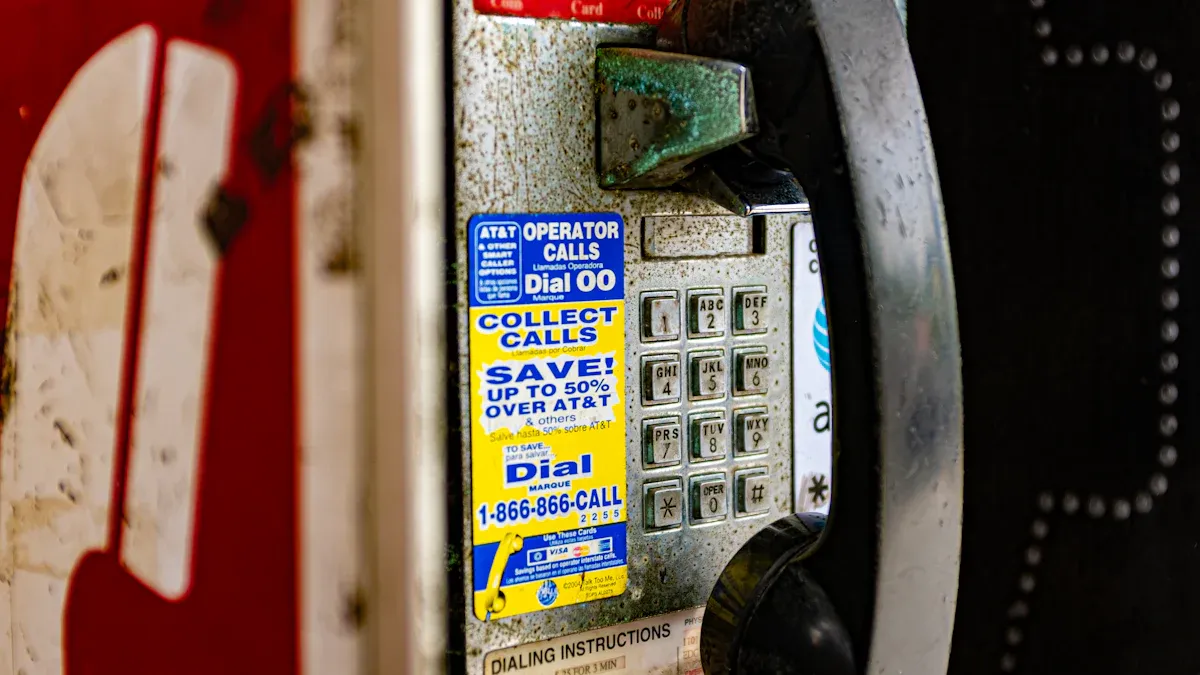
You depend on an Emergency Telephone Hook Switch to work every time. Quality parts and regular checks make a difference. When you act quickly to maintain and install these switches, you help everyone stay safe. Simple steps and routine care keep this vital equipment ready when you need it most.
Key Takeaways
- Choose high-quality, corrosion-resistant materials and gold-plated contacts to ensure your Emergency Telephone Hook Switch lasts and works reliably in all conditions.
- Perform regular monthly tests and preventive maintenance to catch problems early and keep the switch ready for emergencies.
- Install the switch following manufacturer guidelines, protect it from weather and vandalism, and train users to ensure safe and effective operation.
Emergency Telephone Hook Switch: Choose High-Quality Components

Select Robust and Corrosion-Resistant Materials
You want your Emergency Telephone Hook Switch to last in any environment. Choose materials like stainless steel or high-grade plastics. These materials resist rust and damage from moisture. When you select corrosion-resistant parts, you help prevent failures during emergencies. This choice keeps the switch working even in harsh weather or high-humidity areas.
Use Gold-Plated Contacts for Longevity
Gold-plated contacts give you a reliable connection every time you use the switch. Gold does not tarnish or corrode easily. This means the contacts stay clean and conduct electricity well. You reduce the risk of missed calls or faulty signals. Many professionals recommend gold-plated contacts for critical safety equipment.
Tip: Gold-plated contacts may cost more, but they save you money and trouble over time by reducing maintenance needs.
Opt for Tamper-Resistant and Durable Designs
You protect your equipment when you choose tamper-resistant designs. Look for switches with secure housings and reinforced mounting. These features stop vandals and prevent accidental damage. Durable designs also handle frequent use without breaking. You ensure the Emergency Telephone Hook Switch stays ready for anyone who needs it.
- Choose switches with:
- Reinforced covers
- Secure fasteners
- Impact-resistant materials
Emergency Telephone Hook Switch: Implement Rigorous Testing
Perform Regular Functional and Continuity Tests
You need to check your Emergency Telephone Hook Switch often. Regular tests help you find problems before they become serious. Start by pressing the switch and listening for a clear dial tone. Use a multimeter to check the electrical continuity. This tool tells you if the circuit works as it should. If you find any weak signals or interruptions, fix them right away. Make a checklist for each test. This list helps you remember every step and keeps your testing routine organized.
Tip: Schedule these tests monthly. Consistent checks keep your equipment ready for emergencies.
Simulate Real Emergency Conditions
You should not wait for a real emergency to see if your switch works. Create practice drills that copy real-life situations. For example, test the switch during a power outage or in wet conditions. Ask someone to use the switch while wearing gloves. This step shows you if the switch works for everyone, even in tough situations. Record the results of each drill. Use this information to improve your Emergency Telephone Hook Switch setup.
- Practice drills can include:
- Testing during storms
- Using the switch with wet hands
- Checking response time after activation
Emergency Telephone Hook Switch: Schedule Preventive Maintenance
Clean and Inspect Metal Components Routinely
You keep your Emergency Telephone Hook Switch reliable when you clean and inspect its metal parts on a regular schedule. Dust, dirt, and moisture can build up on contacts and hinges. These elements can cause corrosion or block the electrical connection. Use a soft, dry cloth to wipe away debris. For stubborn grime, use a small brush or a gentle cleaner approved for electronics. Always check for signs of rust or discoloration. If you spot any, address it right away to prevent further damage.
Tip: Set a reminder to inspect your switch every month. Consistent care helps you catch problems early.
Replace Worn or Damaged Parts Proactively
You should not wait for a failure before you act. Look for worn springs, cracked housings, or loose connections during each inspection. Replace any part that shows wear or damage. This step keeps your Emergency Telephone Hook Switch working when you need it most. Keep a small supply of replacement parts on hand. Quick swaps reduce downtime and keep your emergency system ready.
- Common parts to check and replace:
- Springs
- Contacts
- Mounting hardware
You protect everyone who depends on emergency communication by staying ahead of problems.
Emergency Telephone Hook Switch: Ensure Proper Installation
Follow Manufacturer Guidelines and Maintain Clearances
You need to follow the manufacturer’s instructions when you install an Emergency Telephone Hook Switch. These guidelines help you avoid mistakes that could cause failures later. Always check the manual before you start. Use the recommended tools and hardware. Make sure you mount the switch at the correct height and location. Leave enough space around the switch for easy access and airflow. This prevents overheating and makes repairs easier.
Tip: Keep a printed copy of the installation guide at the worksite. You can quickly check details if you have questions.
A good installation checklist includes:
- Verifying mounting height and position
- Checking for clearances around the switch
- Securing all fasteners tightly
- Testing the switch after installation
Train Installers and Users for Safe Operation
You improve safety when you train both installers and users. Installers need to know how to handle the Emergency Telephone Hook Switch without damaging it. Show them how to connect wires and secure the housing. Users should learn how to operate the switch in an emergency. Practice drills help everyone feel confident.
- Hold short training sessions for new staff
- Use simple instructions and hands-on practice
- Review safety rules and emergency steps
Note: Well-trained people make fewer mistakes and respond faster during real emergencies.
Emergency Telephone Hook Switch: Protect Against Environmental Hazards

Use Weather-Resistant and Sealed Enclosures
You need to keep your switch safe from rain, snow, and extreme temperatures. Choose enclosures made from tough materials like polycarbonate or stainless steel. These materials block water and resist UV rays. Sealed enclosures stop moisture from getting inside and damaging the electrical parts. You should look for enclosures with a high IP (Ingress Protection) rating. This rating tells you how well the box keeps out water and dust.
Tip: Always check the enclosure seals after storms or cleaning. Replace any damaged gaskets right away.
A weather-resistant enclosure helps your switch last longer. You avoid costly repairs and keep your emergency system ready.
Guard Against Dust, Moisture, and Vandalism
You must protect your switch from dust and dirt. Dust can build up and block the contacts. Moisture can cause rust and short circuits. Use dust covers and rubber gaskets to keep out unwanted particles. Place the switch in a spot that stays dry and clean.
Vandalism can also threaten your equipment. Install the switch in a visible area with good lighting. Use tamper-proof screws and reinforced covers. You can add security cameras or warning signs to stop vandals.
- Ways to guard your switch:
- Use dust covers and seals
- Choose tamper-resistant hardware
- Place warning signs nearby
Note: Regular checks help you spot problems early. Quick action keeps your switch safe and working.
Emergency Telephone Hook Switch: Monitor and Respond to Failures
Set Up Monitoring and Alert Systems
You need to know when your switch stops working. Install monitoring systems that check the status of your equipment at all times. These systems can send alerts if they detect a problem. Use sensors that track power, connection, and physical condition. Connect these sensors to a central control panel or a remote monitoring service. This setup helps you respond quickly to any issue.
Tip: Choose alert systems that send notifications by text, email, or alarm. Fast alerts help you fix problems before they become emergencies.
A simple monitoring checklist can include:
- Power supply status
- Line connection checks
- Physical tampering detection
Establish Rapid Repair and Replacement Protocols
You must act fast when a failure happens. Create a clear plan for repairs and replacements. Train your team to follow this plan step by step. Keep spare parts and tools ready in an easy-to-reach location. Assign roles so everyone knows what to do during a breakdown.
- Steps for rapid response:
- Identify the problem using monitoring alerts.
- Notify the repair team right away.
- Replace or fix the faulty part.
- Test the switch after repair.
- Record the incident for future review.
Note: A quick response keeps your emergency system reliable and safe for everyone.
Emergency Telephone Hook Switch: Enhance Safety and Usability
Consider Ergonomic Design and User Access
You want everyone to use the switch quickly and safely. Choose a design that fits all hand sizes. Large, easy-to-press buttons help people in a hurry. Bright colors and clear labels make the switch easy to spot, even in low light. Place the switch at a height that works for children, adults, and people in wheelchairs. Smooth edges and non-slip surfaces prevent injuries.
- Features to look for:
- Large, visible buttons
- Clear, simple instructions
- Accessible mounting height
Tip: Test the switch with different users. Ask for feedback to improve comfort and access.
Apply Contact Protective Circuits and Warning Signs
You protect users and equipment when you add contact protective circuits. These circuits stop sparks and reduce wear on the switch. They also help prevent electrical shocks. Use warning signs to guide people during emergencies. Place signs near the switch with simple words and symbols. Bright colors and reflective materials make signs easy to see, even in the dark.
| Protective Feature | Benefit |
|---|---|
| Protective Circuits | Prevents damage, sparks |
| Warning Signs | Guides users, boosts safety |
Note: Regularly check signs and circuits. Replace faded signs and test circuits to keep everything safe.
You keep your emergency communication system dependable when you focus on quality, regular testing, and preventive care. Protect switches from harsh environments and install them correctly. Quick action during issues ensures safety for everyone. Your attention to detail helps extend the lifespan of this vital equipment.
FAQ
How often should you test an Emergency Telephone Hook Switch?
You should test your switch every month. Regular checks help you find problems early and keep your emergency system ready.
Tip: Set a calendar reminder for monthly testing.
What should you do if the switch fails during a test?
Replace or repair the faulty part right away. Always test the switch again after fixing it to make sure it works.
Can you install an Emergency Telephone Hook Switch outdoors?
Yes, you can. Use a weather-resistant enclosure and check seals often. Outdoor switches need extra protection from rain, dust, and vandalism.
- Use sealed enclosures
- Inspect after storms


